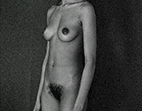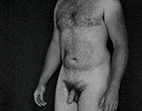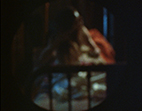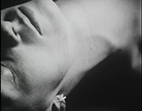Turning Torso Draw Down / Beautiful Movie / Fades and Close-Ups
- Robert Huot |
- 1971-1978 |
- 29 minutes |
- BOTH
Turning Torso Draw Down
"...(a) serialist comparison-contrast of the variations in nine naked male and female torsos. The film is divided into three sections. During the first, the torsos slowly make complete clockwise turns (except for three instances when the torso of a young boy turns counter-clockwise), each of which lasts approximately twenty-five seconds. At the end of each turn, a two-second dissolve acts as a transition to the next turn. During the second section, Huot presents a six frame review (the film is run at 16fps) of the torsos, this time standing still, in the same order. And, in the final section, Huot presents a second complete six-frame review, this time with six frames of blue leader regularly in the position of '4'. The finished film creates both formal and thematic investigations. While the variations among the bodies are interesting, the relative similarity of some of the bodies forces us to ask ourselves, 'Now, is this the same body I saw a minute ago, or is the lighting or texture or positioning fooling me?' We become so aware of tiny variations in these elements that when we see the young boy's body, obviously filmed differently and turning in a different direction, the change is startling. Drawdown, incidentally, refers to a process Huot used when he worked as a paint chemist; the process involves spreading samples of paint on a flat surface so that one can make the most numerous comparisons of different samples within a particular space." - Scott MacDonald, The Films of Robert Huot: 1967-1972, Quarterly Review of Film Studies, Summer 1980
Beautiful Movie
"...is a filmic cameo during which a passage of blue film leader and clear film painted red introduces a lovely image of a woman, naked from the waist up, sutting on a brass bed, combing her hair. When we first see the woman, she is well out of focus, but during the following minute or so she slowly becomes clear. As soon as the image is completely clear, however, Huot dissolves to an image of himself sitting in a similar position, combing his own hair. This image quickly goes out of focus, and the viewer sees the original passage of leader and painted film, this time in reverse, forming the other half of a filmic frame. BEAUTIFUL MOVIE is a quietly feminist work; Huot revised the traditional tendency to worship female beauty by suggesting that, yes women are lovely, but there is no physical reason why men cannot be lovely in the same way." - Scott MacDonald, The Films of Robert Huot: 1967-1972, Quarterly Review of Film Studies, Summer 1980
Fades and Close-Ups
"...was shot in black and white Super 8mm and is accompanied by a soundtrack of drumming and deep breathing. The camera fades in and out on a symmetrical series of lovely, grainy close-ups of the naked, apparently sleeping forms of a male and a female (Huot himself and Carol Kinne). The film is closely related to, and would be especially interesting screened with Willard Maas' GEOGRAPHY OF THE BODY, Taka Iimura's LOVE, and Yoko Ono's FLY." - Scott MacDonald, The Films of Robert Huot: 1967-1972, Quarterly Review of Film Studies, Summer 1980





